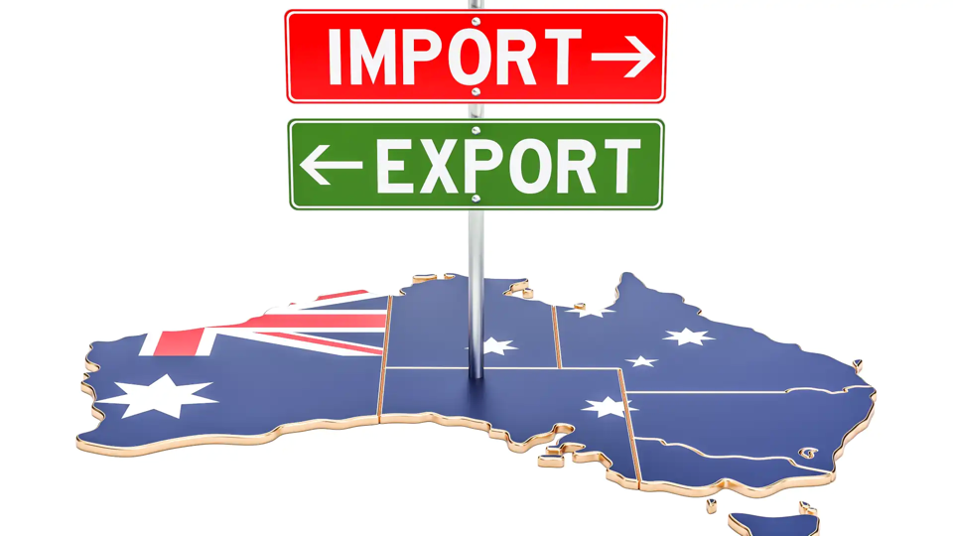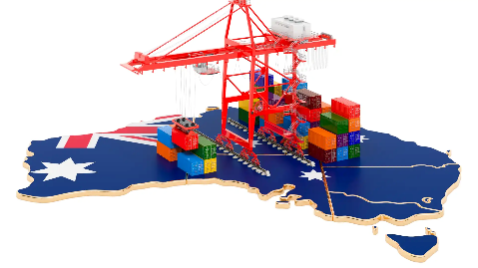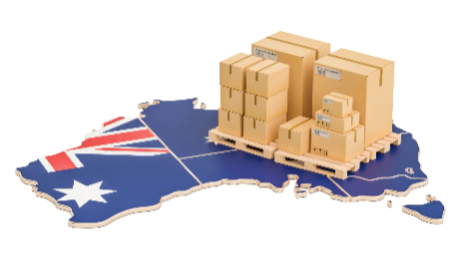
International trade plays a vital role in the Australian economy, particularly in the country’s shipping and logistics sectors. As an island nation, we rely heavily on importing and exporting all kinds of goods, from cars to cows, to bolster our economy.
As Australia’s go-to international freight company, we’ll take a closer look at Australia’s top 10 imports and exports in 2023, exploring the key industries and partners that shape the nation’s international trade landscape. We’ll also look ahead to see what 2024 has in store. By understanding the latest trade data, we can gain insights into the economic trends and priorities driving Australia’s position in the global marketplace.

Australia’s Top 10 Imports in 2023
- Petroleum oils (not crude): $50.75 billion
- Motor vehicles for passengers: $34.8 billion
- Motor vehicles for goods transport: $16.965 billion
- Electrical apparatus for telephony: $12.9485 billion
- Automatic data processing machines: $10.295 billion
- Medicaments: $8.961 billion
- Unwrought or semi-manufactured gold: $8.265 billion
- Crude petroleum oils: $7.9605 billion
- Blood and immunological products: $6.5975 billion
- Construction machinery: $4.6255 billion
(Figures Taken from the Australian Department of Foreign Affairs and Trade)
In 2023, Australia’s import industry experienced a downturn, with totals decreasing from $309 billion in 2022 to $287 billion, a 6.93% decline. This drop highlights broader challenges, including lingering global economic disruptions, regional tensions, and the fluctuating Australian dollar, which increased the cost of imports.
However, the outlook for 2024 is more promising. As global markets stabilise and domestic demand strengthens, there is a ray of hope for the import industry. We anticipate a gradual recovery, particularly in the technology and renewable energy sectors. This positive trend will be influenced by the stability of the Australian dollar and the continued preference for sustainable, locally-produced goods, which will help to balance the potential growth in imports.
Here is an overview of the top 10 Australian imports in 2023 and a glimpse into how 2024 is shaping up.
1. Petroleum oils (not crude)
In 2023, refined petroleum products led Australia’s imports, reaching $50.75 billion, which constituted 12.3% of all imports. These imports are crucial for powering industries like manufacturing, construction, and agriculture. As 2024 progresses, demand for imported fuel will likely remain high due to increasing economic activities and travel recovery post-Covid. However, Australia’s shift towards renewable energy and sustainability could gradually reduce reliance on traditional petroleum products in the future.
2. Motor Vehicles for Passengers
In 2023, Australia’s imports of passenger vehicles hit $34.8 billion, accounting for 8.68% of total imports. This reflects Australians’ strong preference for high-quality, foreign-made cars known for advanced technology and reliability. Luxury and speciality vehicles from European and Japanese manufacturers remain particularly popular. With improving economic conditions and rising consumer confidence, the import of passenger vehicles is expected to grow further in 2024.
3. Motor vehicles for goods transport
In 2023, Australia imported $16.965 billion worth of commercial vehicles for goods transport, making up 4.07% of total imports. These vehicles are essential for maintaining Australia’s supply chain across industries like retail, construction, and manufacturing. With continued infrastructure development and urban expansion, the demand for these durable trucks and vans, ideal for navigating Australia’s vast landscapes, is expected to stay robust.
4. Electrical Apparatus for Telephony
In 2023, Australia imported $8.93 billion AUD worth of electrical apparatus for telephony, making up 3.1% of total imports. These essential imports, primarily smartphones and communication infrastructure, cater to Australia’s growing demand for connectivity and advanced telecommunications. Looking ahead to 2024, ongoing technological advancements and the expansion of digital networks are expected to sustain high demand in this sector.
5. Automatic Data Processing Machines
In 2023, Australia’s investment in automatic data processing machines reached $10.295 billion, representing 2.46% of total imports. This category includes computers and servers that are vital for supporting Australia’s expanding digital economy and tech-driven sectors. With the tech sector’s growth projected at 5% annually, demand for these critical components is expected to increase in 2024 as more businesses and services digitalise.
6. Medicaments
Australia imported $8.961 billion worth of medicaments in 2023, accounting for approximately 2.14% of all imports. This import activity is essential for supplementing the domestic production of pharmaceuticals, especially in high-demand areas like biotech and prescription medications. With healthcare spending anticipated to grow by 6% in the next year, the demand for imported medicaments is likely to continue rising.
7. Unwrought or Semi-manufactured Gold
The import of unwrought or semi-manufactured gold stood at $8.265 billion in 2023, comprising 1.98% of Australia’s total imports. These figures support not only the jewellery industry but also financial sectors that use gold as a hedge against economic volatility. With market uncertainties and a projected increase in global gold prices by 10% in the upcoming year, the import volume is expected to remain robust.
8. Crude Petroleum Oils
In 2023, Australia imported crude petroleum oils worth $7.9605 billion, accounting for 1.9% of total imports. This is crucial for Australia’s energy sector, which relies on oil for about 40% of its energy consumption. As the global oil demand is expected to rise by 3% in 2024, Australia’s dependency on imported crude will likely persist.
9. Blood and Immunological Products
Imports of blood and immunological products were valued at $6.5975 billion, representing 1.58% of Australia’s total imports in 2023. These products are critical for therapies and research in sectors like immunotherapy, which has a compound annual growth rate (CAGR) of 8%. This upward trend is set to continue as advancements in healthcare drive demand.
10. Construction Machinery
Australia’s construction machinery imports amounted to $4.6255 billion in 2023, making up 1.11% of total imports. This sector supports a construction industry that contributes 9% to the national GDP. With a forecasted growth of 4% in construction activities next year, driven by both residential and commercial projects, the demand for advanced machinery will remain high.

Australia’s Top 10 Exports in 2023
- Iron ores and concentrates: $130.5 billion
- Coal: $97.15 billion
- Petroleum gases: $72.5 billion
- Gold: $27.26 billion
- Cereals: $18.27 billion
- Meat and edible meat offal: $16.965 billion
- Commodities not specified: $10.5125 billion
- Inorganic chemicals: $9.0625 billion
- Machinery and mechanical appliances: $7.6415 billion
- Oil seeds and oleaginous fruits: $6.467 billion
(Figures Taken from TrendEconomy and converted in Australian dollars)
In 2023, Australia’s merchandise exports were valued at $369 billion, marking a 9.99% decrease from 2022’s $410 billion. This downturn reflects challenges in global markets and shifts in commodity demand. As we look towards 2024, the Australian export sector is poised for a potential rebound, driven by recovering global economies and increased demand for Australia’s diverse resources, including minerals and agricultural products. The evolving emphasis on sustainability could also reshape export dynamics as Australia intensifies its focus on renewable energy technologies and environmentally friendly goods.
Below is an overview of the top 10 Australian exports in 2023 and a glimpse into what 2024 has in store for the export industry.
1. Iron Ores And Concentrates
With $130.5 billion in exports, iron ore demand was driven by robust global infrastructure and urbanisation, especially in Asia. As a key ingredient in steel-making, Australia’s vast reserves kept it at the forefront of the global supply chain. The outlook for 2024 remains strong, with sustained demand expected from the construction and automotive industries.
2. Coal
Despite global energy transitions, coal exports valued at $97.15 billion reflected ongoing demand for high-quality Australian coal, used primarily in energy production and steel manufacturing. This demand is expected to fluctuate in 2024 as more countries adopt renewable energy sources.
3. Petroleum gases
Exports worth $72.5 billion were boosted by the global energy shortfall and the search for cleaner fossil fuel options like LNG. The trend towards energy diversification in 2024 will likely maintain strong demand for Australian LNG.
4. Gold
Economic uncertainties often push investors towards stable assets like gold, with exports reaching $27.26 billion. The volatile global economy suggests that gold will continue to be a key export in 2024.
5. Cereals
Contributing $18.27 billion, cereals like wheat and meslin met critical global food supply needs. Expectations for 2024 include steady demand driven by global population growth and food security concerns.
6. Meat and Edible Meat Offal
With exports of $16.965 billion, high-quality Australian meat found markets, particularly in Asia, where increasing affluence is raising protein consumption. The trend is likely to continue into 2024, supporting the growth of this sector.
7. Commodities not Specified
This diverse category, bringing in $10.5125 billion, illustrates Australia’s flexibility in meeting varied international demands. The variety of exports included is expected to evolve as the market needs a shift in 2024.
8. Inorganic Chemicals
As the world increasingly turns to technology and renewables, the $9.0625 billion from this sector highlights the critical role of Australian chemicals in various industries. This segment is poised for growth as global manufacturing and renewable energy sectors expand.
9. Machinery and Mechanical Appliances
The $7.6415 billion in exports underlines Australia’s strong capabilities in manufacturing and technology, which are essential for global industries aiming to enhance efficiency and automation. The demand in this sector is likely to increase in 2024 as industries continue to modernise.
10. Oil Seeds and Oleaginous Fruits
Valued at $6.467 billion, these exports are becoming increasingly significant due to their use in producing vegetable oils and biofuels, aligning with global shifts towards sustainable resources. The growing biofuel industry will likely bolster demand for these products in the coming year.
Australia’s Top Five Trading Partners in 2023
- China
- Japan
- South Korea
- India
- United States
In 2023, Australia’s international trade was defined by robust relationships with five key global players: China, Japan, South Korea, India, and the United States. These nations played pivotal roles across both the import and export sectors of Australia’s economy, underpinning its global trade dynamics.
These relationships were reinforced by various bilateral and multilateral trade agreements, as well as mutual economic interests that facilitated a healthy cross-border flow of goods. Critical Australian exports like coal, iron ore, natural gas, and beef found robust markets, while the nation imported vital technology products and manufacturing inputs.
Maintaining strong trade ties with these five major economies proved crucial for Australia’s economic wellbeing. By nurturing partnerships with such global heavyweights, Australia secured vital lifelines to worldwide markets and supply chains.
1. China
In 2023, China continued as Australia’s largest trading partner, significantly impacting both imports and exports. China imported Australian commodities valued at approximately $174 billion, dominated by iron ore, coal, and natural gas, which collectively accounted for 32% of Australia’s total exports. This trade dynamic underscores China’s critical role in sourcing Australian resources essential for its vast manufacturing and construction industries.
On the flip side, Australia imported around 102.95 billion worth of goods from China, including electronics, machinery, and textiles, marking a substantial interdependence that persevered despite ongoing political tensions.
2. Japan
Japan was a key export destination for Australia in 2023, particularly for coal, natural gas, and beef, reflecting a longstanding and mutually beneficial trade relationship. Japan ranks as Australia’s second-largest trading partner, importing $52.2 billion worth of Australian goods.
The partnership is underpinned by the Japan-Australia Economic Partnership Agreement, enhancing trade ties and reducing tariffs, which has facilitated smoother access to Japanese markets for Australian exporters and vice versa for Japanese automobiles and technology products entering Australia.
3. South Korea
South Korea is a crucial export market for Australian goods, importing $29 billion worth of goods, particularly coal, iron ore, and beef. In 2023, trade between the two countries remained strong, supported by the Korea-Australia Free Trade Agreement (KAFTA).
South Korea’s imports from Australia helped fuel its technological and automotive industries, while Australia benefited from importing South Korean electronics and vehicles. The trade relationship continued to thrive on the back of shared economic interests and strategic cooperation.
4. India
India’s economic growth has made it an increasingly important trade partner for Australia, particularly in the fields of coal, education, and agricultural products. In 2023, India imported over $23.345 billion worth of goods from Australia, showcasing significant growth.
The relationship is bolstered by the Comprehensive Economic Cooperation Agreement, aiming to reduce trade barriers and increase bilateral trade. India’s demand for Australian resources and services is expected to grow as its economy expands and urbanises.
5. United States
The United States remained a significant trade partner for Australia in 2023, with strong import and export activities. The U.S. primarily imported Australian beef, wine, and pharmaceuticals, while Australia benefited from U.S. machinery, medical instruments, and technology products, totalling $18.125 billion.
The trade relationship is supported by the Australia-United States Free Trade Agreement (AUSFTA), which has greatly reduced tariffs and fostered a strong investment flow between the two nations, enhancing their economic ties and market access.
Are You Importing or Exporting?
Take advantage of Australia’s booming international trade with Jacanna, your international freight forwarding partner. Whether your industry sits under one of these top 10 import/export categories or not, we can help you explore numerous opportunities in overseas markets. Get in touch with Jacanna today to discuss our freight forwarding services further.